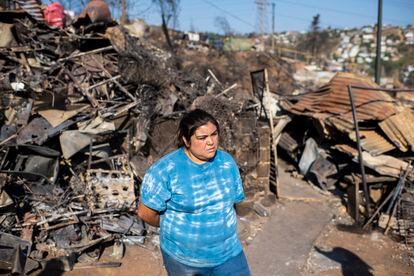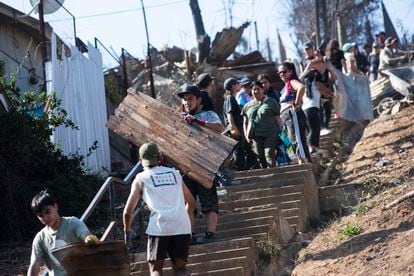With his face sooty from collecting debris, Oscar Montecinos, 36, seems not to know whether to smile or cry. He completely lost his house. And he emphasizes, with sadness, that he was not able to save his two dogs, that the next morning, when he was just able to return, he found them burned. But he escaped the giant flames, which he describes as “more than four meters”, along with his wife and his children, aged nine and three.
He lives in the Achupallas sector, next to El Olivar, one of the most affected in Viña del Mar by the forest fires that hit the south-central area of Chile starting Friday and for five days. Its streets, some narrow, made it very difficult for its inhabitants, and for many impossible, to escape. That afternoon, when the weekend was almost beginning, they came home from work to rest. Many, they say, were about to take a shower; others had finally sat down in an armchair to watch television. But, suddenly, a tragedy began that, according to the latest figures, has claimed 131 lives. It is the worst that has been recorded, said President Gabriel Boric, since the earthquake and tsunami of February 27, 2010.
Montecinos did not think, he says, that when he saw how the hills in front were on fire, and also the Botanical Garden of Viña, that that fire that he saw so far away would suddenly devour his living room, his bedroom, his kitchen, his 12-year history there. . The flames reached her neighbor across the street, and also at least four neighbors who lived around the corner, on Escala Huasco Street. “I prefer an earthquake than a fire. This was like an atomic bomb,” says Oscar with the experience of a Chilean who has already experienced a mega earthquake, and now a mega fire.
The afternoons when they put the world to rights
After the fire in Achupallas, the images of cars burned in the middle of driving were shocking. But much more were the hundreds of houses destroyed by the fire, except for about four or maybe five that no one knows how – nor can their owners explain – were not destroyed by the flames. Aurora Salinas is one of those owners; She lives on Luis Hurtado López street, the main one. She is still shocked that the building is standing, even though the fire devastated her yard. She has taken out a small table with clothes, sanitary towels and a one-liter sunscreen to offer to whoever needs it. She says it all started when the palm tree in front caught fire.
The smell of burning, the rubble with soot, the gray and black cans that were part of their buildings, but above all the memory of that Saturday at dawn, when the inhabitants of Achupallas returned to their neighborhood and many saw the corpses of their neighbors. or family members on the streets, it is an image that has remained engraved in them. But recorded as if everything had just happened.

He passed on the Huasco de Achupallas staircase, which connects Luis Hurtado López street with the highest part of the Viñamarino hill. Its metal railings and more than 170 concrete steps, with eight landings in 90 linear meters, and its former green areas, seem intact despite what happened right there. The steps hide the tragedy that happened on the night of Friday the 2nd. Five neighbors, who had known each other for many years, and whose houses located on both sides of the building caught fire, died either inside their homes or while escaping down those steps.
Camila Martínez, 31, lived in one of those houses. The staircase is a sector where nothing was left standing. She was born in this place and has witnessed how it changed over time. She is sad and, unlike her husband Rodrigo Herrera, 32, who sweeps what she can with a broom in what until Friday was the place where she lived, she still cannot start cleaning. She says she has no spirit. Next to her is Juana Jara, her mother, the protagonist of when she started her family there 33 years ago. Both that afternoon had gone on a walk with the neighborhood center to Pomaire, a town 50 kilometers from Santiago, famous for its clay crafts. She regrets having gone but, like everyone else, she had no way of knowing what would happen when evening fell in Viña del Mar.
On what was Camila's house and her mother's, there are vestiges of what was another home. Her uncle Alejandro Flores lived there with his wife Cristina. Camila remembers that every day she would greet him from his window, while he busily pruned a tree that she carefully maintained with a round crown. Today that tree is a wiry, charred trunk. “I lost my uncle,” Camila suddenly says. “He was a very important person here. He was the president of this street.”
It was Alejandro Flores who, Camila and her mother say, was one of the promoters of the construction of the Huasco staircase, which was delivered in 2021 by the local authorities of the Government of the now deceased former president Sebastián Piñera. “When I was a child I would slip in the mud here. Before this was pure land, and thanks to my uncle we have a staircase. “He always looked for the best for his street.”
In a government video On July 22, 2019, when work on the staircase began, Alejandro Flores can be seen happy. “I only have words to thank for everything we have advanced today. And we hope that when we inaugurate this street, those of us who are here will go all out to celebrate the change,” he said excitedly.

Flores and his wife fled their house down the Huasco staircase. They were found dead on an adjacent climb. They are two of the five residents of this sector who perished in the fire. Rodrigo Herrera remembers Don Antonio and his daughter Sandra, who lived a few houses down. Both died escaping the flames.
Before the fire, some neighbors had planted fruit trees in the green areas of the stairs. It was a place of both pedestrian traffic and meeting. Rodrigo Herrera remembers that on those steps he, along with Flores and Don Antonio, would sit and talk in the afternoons to relax for a while after work. It was a kind of routine that used to start when Flores went to buy bread on Luis Hurtado López Street – where there was only one small business left standing, El Hornito – and he asked his neighbors if they wanted to order from him too. Upon returning, the gathering began, now unforgettable. “We sat down to fix the world by painting [a la manera] of us,” he recalls.
Herrera remembers another neighbor, Adan, who climbed the steps every day. He was sometimes the fourth one to join those afternoon conversations. He was 54 years old and they called him the charro or the Mexican. He was a fan of the rancheras, and known because on every birthday he sang them. He lived on the Huasco staircase with his two nieces, up the hill.
At the end of the Huasco stairs lives Luis García, 51, a resident of El Charro. He is in the yard of his house, and it is still difficult for him to believe that it did not catch fire, even though at the base of it, since it is built in a ravine, he has dozens of tires that confirm the construction. He gets emotional remembering when he found her standing on Saturday morning; but he does not forget those who he saw lying in the street. When he remembers, his eyes moisten. Next to him is Violeta, one of the nieces that Adan raised.

Violeta says that Friday was her day off, and like rarely she went to the beach with her sister. She was struck by the fact that Adan did not call them in the afternoon, because she always did it several times a day. “He was very concerned about us,” she says. But when they found out about the fire, they were the ones who called him and called him on the phone. He never responded.
At no time did they think the worst. Adan was, described by his niece and his neighbor Luis García, a happy guy, a lover of his bicycle and his various dogs, as well as agile and sporty. That's why no one can explain why that Friday, when the entire neighborhood was on fire, Charro didn't leave his house.
Subscribe here to the EL PAÍS Chile newsletter and receive all the key information on current events in the country.
#tragedy #Viña #del #Mar #staircase #friends #died #flames